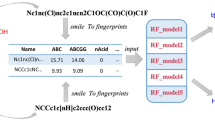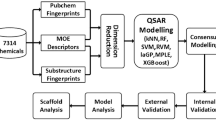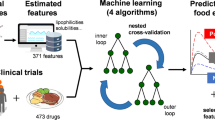Abstract
Purpose
Oral bioavailability (%F) is a key factor that determines the fate of a new drug in clinical trials. Traditionally, %F is measured using costly and time-consuming experimental tests. Developing computational models to evaluate the %F of new drugs before they are synthesized would be beneficial in the drug discovery process.
Methods
We employed Combinatorial Quantitative Structure-Activity Relationship approach to develop several computational %F models. We compiled a %F dataset of 995 drugs from public sources. After generating chemical descriptors for each compound, we used random forest, support vector machine, k nearest neighbor, and CASE Ultra to develop the relevant QSAR models. The resulting models were validated using five-fold cross-validation.
Results
The external predictivity of %F values was poor (R2 = 0.28, n = 995, MAE = 24), but was improved (R2 = 0.40, n = 362, MAE = 21) by filtering unreliable predictions that had a high probability of interacting with MDR1 and MRP2 transporters. Furthermore, classifying the compounds according to the %F values (%F < 50% as “low”, %F ≥ 50% as ‘high”) and developing category QSAR models resulted in an external accuracy of 76%.
Conclusions
In this study, we developed predictive %F QSAR models that could be used to evaluate new drug compounds, and integrating drug-transporter interactions data greatly benefits the resulting models.









Similar content being viewed by others
Abbreviations
- %F:
-
Oral bioavailability
- AD:
-
Applicability domain
- ANOVA:
-
Analysis of variance
- CCR:
-
Correct classification rate (balanced accuracy)
- CNT:
-
Continuous activity scale
- Combi-QSAR:
-
Combinatorial quantitative structure-activity relationship
- CPT:
-
Consensus prediction threshold
- CTG:
-
Category activity scale
- CYP:
-
Cytochrome P450
- D:
-
Dragon descriptors
- HIT:
-
Human intestinal transporter
- kNN:
-
k nearest neighbor
- MAE:
-
Mean absolute error
- MDR1:
-
Multidrug resistance protein 1 (P-gp, ABCB1)
- MOE:
-
Molecular Operating Environment
- MPOI:
-
Mean probability of interaction
- MRP2:
-
Multidrug resistance-associated protein 2 (ABCC2)
- POI:
-
Probability of interaction
- QSAR:
-
Quantitative structure-activity relationship
- R2 :
-
Coefficient of determination
- RF:
-
Random forest
- SVM:
-
Support vector machine
References
Buxton IL, Benet LZ. Chapter 2. Pharmacokinetics: the dynamics of drug absorption, distribution, metabolism, and elimination. In: Brunton LL, Chabner BA, Knollmann BC, editors. Goodman & Gilman’s the pharmacological basis of therapeutics. 12th ed. New York: McGraw-Hill; 2011.
Andrews CW, Bennett L, Yu LX. Predicting human oral bioavailability of a compound: development of a novel quantitative structure-bioavailability relationship. Pharm Res. 2000;17:639–44.
Moda TL, Montanari CA, Andricopulo AD. Hologram QSAR model for the prediction of human oral bioavailability. Bioorgan Med Chem. 2007;15:7738–45.
Ma CY, Yang SY, Zhang H, Xiang ML, Huang Q, Wei YQ. Prediction models of human plasma protein binding rate and oral bioavailability derived by using GA–CG–SVM method. J Pharmaceut Biomed. 2008;47:667–82.
Tian S, Li Y, Wang J, Zhang J, Hou T. ADME evaluation in drug discovery. 9. Prediction of oral bioavailability in human based on molecular properties and structural fingerprints. Mol Pharm. 2011;8:841–51.
Lipinski CA, Lombardo F, Dominy BW, Feeney PJ. Experimental and computational approaches to estimate solubility and permeability in drug discovery and development settings. Adv Drug Deliver Rev. 2001;46:3–26.
Veber DF, Johnson SR, Cheng HY, Smith BR, Ward KW, Kopple KD. Molecular properties that influence the oral bioavailability of drug candidates. J Med Chem. 2002;45:2615–23.
Hou T, Wang J, Zhang W, Xu X. ADME evaluation in drug discovery. 6. Can oral bioavailability in humans be effectively predicted by simple molecular property-based rules? J Chem Inf Model. 2007;47:460–3.
Martin YC. A bioavailability score. J Med Chem. 2005;48:3164–70.
Varma MVS, Obach RS, Rotter C, Miller HR, Chang G, Steyn SJ, et al. Physicochemical space for optimum oral bioavailability: contribution of human intestinal absorption and first-pass elimination. J Med Chem. 2010;53:1098–108.
Paixão P, Gouveia LF, Morais JAG. Prediction of the human oral bioavailability by using in vitro and in silico drug related parameters in a physiologically based absorption model. Int J Pharm. 2012;429:84–98.
Thummel KE, Shen DD, Isoherranen N. Appendix II. Design and optimization of dosage regimens: pharmacokinetic data. In: Brunton LL, Chabner BA, Knollmann BC, editors. Goodman & Gilman’s the pharmacological basis of therapeutics. 12th ed. New York: McGraw-Hill; 2011.
Hou T, Li Y, Zhang W, Wang J. Recent development of in silico predictions of intestinal absorption and bioavailability. Comb Chem High T Scr. 2009;12:497–506.
Zhu J, Wang J, Li Y, Hou T. Recent progress of in silico predictions of oral bioavailability. Comb Chem High T Scr. 2011;14:362–75.
CASE Ultra 1.4.4.6 32 bit, Multicase Inc, Beachwood, OH 44122, USA.
PubChem. http://pubchem.ncbi.nlm.nih.gov/
Benet LZ, Broccatelli F, Oprea TI. BDDCS applied to over 900 drugs. AAPS J. 2011;13:519–47.
Breiman L. Random forests. Mach Learn. 2001;45:5–32.
Vapnik VN. In the nature of statistical learning theory. New York: Springer; 2000.
Kovatcheva A, Golbraikh A, Oloff S, Xiao TD, Zheng W, Wolschann P, et al. Combinatorial QSAR of ambergris fragrance compounds. J Chem Inf Comput Sci. 2004;44:582–95.
Kovatcheva A, Golbraikh A, Oloff S, Feng J, Zheng W, Tropsha A. QSAR modeling of datasets with enantioselective compounds using chirality sensitive molecular descriptors. SAR QSAR Environ Res. 2005;16:93–102.
Votano JR, Parham M, Hall LM, Hall LH, Kier LB, Oloff S, et al. QSAR modeling of human serum protein binding with several modeling techniques utilizing structure information representation. J Med Chem. 2006;49:7169–81.
Dalgaard P. Introductory statistics with R. New York: Springer; 2008.
Zheng W, Tropsha A. Novel variable selection quantitative structure–property relationship approach based on the k-nearest-neighbor principle. J Chem Inf Comput Sci. 2000;40:185–94.
Chakravarti SK, Saiakhov RD, Klopman G. Optimizing predictive performance of CASE Ultra expert system models using the applicability domains of individual toxicity alerts. J Chem Inf Model. 2012;52:2609–18.
Saiakhov RD, Chakravarti SK, Klopman G. Effectiveness of CASE Ultra expert system in evaluating adverse effects of drugs. Mol Inf. 2013;32:87–97.
Tropsha A, Golbraikh A. Predictive QSAR modeling workflow, model applicability domains, and virtual screening. Curr Pharm Design. 2007;13:3494–504.
Golbraikh A, Shen M, Xiao Z, Xiao YD, Lee KH, Tropsha A. Rational selection of training and test sets for the development of validated QSAR models. J Comput Aided Mol Des. 2003;17:241–53.
Sedykh A, Fourches D, Duan J, Hucke O, Garneau M, Zhu H, et al. Human intestinal transporter database: QSAR modeling and virtual profiling of drug uptake, efflux and interactions. Pharm Res. 2013;30:996–1007.
Giacomini KM, Sugiyama Y. Chapter 5. Membrane transporters and drug response. In: Brunton LL, Chabner BA, Knollmann BC, editors. Goodman & Gilman’s the pharmacological basis of therapeutics. 12th ed. New York: McGraw-Hill; 2011.
Zhang L, Fourches D, Sedykh A, Zhu H, Golbraikh A, Ekins S, et al. Discovery of novel antimalarial compounds enabled by QSAR-based virtual screening. J Chem Inf Model. 2013;53:475–92.
Fisher RA. The design of experiments. 8th ed. Edinburgh: Oliver and Boyd; 1966.
Shugarts S, Benet LZ. The role of transporters in the pharmacokinetics of orally administered drugs. Pharm Res. 2009;26:2039–54.
Inoue M, Morikawa M, Tsuboi M, Ito Y, Sugiura M. Comparative study of human intestinal and hepatic esterases as related to enzymatic properties and hydrolyzing activity for ester-type drugs. Japan J Pharmacol. 1980;30:529–35.
Dubertret L, Alirezai M, Rostain G, Lahfa M, Forsea D, Niculae BD, et al. The use of lymecycline in the treatment of moderate to severe acne vulgaris: a comparison of the efficacy and safety of two dosing regimens. Eur J Dermatol. 2003;13:44–8.
Spearman C. The proof and measurement of association between two things. Am J Psychol. 1904;15:72–101.
Kornbrot D. Pearson product moment correlation. In: Everitt B, Howell D, editors. Encyclopedia of statistics in behavioral science. Hoboken: Wiley; 2005.
Utvik TIR, Johnsen S. Bioavailability of polycyclic aromatic hydrocarbons in the north sea. Environ Sci Technol. 1999;33:1963–9.
Herman RB. Theory of hydrophobic bonding. II. Correlation of hydrocarbon solubility in water with solvent cavity surface area. J Phys Chem. 1972;76:2754–9.
Birnbaum L. The role of structure in the disposition of halogenated aromatic xenobiotics. Environ Health Persp. 1985;61:11–20.
Stillwell WG, Turesky RJ, Sinha R, Skipper PL, Tannenbaum SR. Biomonitoring of heterocyclic aromatic amine metabolites in human urine. Cancer Lett. 1999;143:145–8.
Holland RD, Gehring T, Taylor J, Lake BG, Gooderham NJ, Turesky RJ. Formation of a mutagenic heterocyclic aromatic amine from creatinine in urine of meat eaters and vegetarians. Chem Res Toxicol. 2005;18:579–90.
Saitoh H, Gerard C, Aungst BJ. The secretory intestinal transport of some beta-lactam antibiotics and anionic compounds: a mechanism contributing to poor oral absorption. J Pharmacol Exp Ther. 1996;278:205–11.
Nielsen AB, Frydenvang K, Liljefors T, Buur A, Larsen C. Assessment of the combined approach of N-alkylation and salt formation to enhance aqueous solubility of tertiary amines using bupivacaine as a model drug. Eur J Pharm Sci. 2005;24:85–93.
Sawa M, Mizuno K, Harada H, Tateishi H, Arai Y, Suzuki S, et al. Tryptamine-based human β3-adrenergic receptor agonists. Part 3: improved oral bioavailability via modification of the sulfonamide moiety. Bioorg Med Chem Lett. 2005;15:1061–4.
Wu C, Decker ER, Blok N, Li J, Bourgoyne AR, Bui H, et al. Acyl substitution at the ortho position of anilides enhances oral bioavailability of thiophene sulfonamides: TBC3214, an ETA selective endothelin antagonist. J Med Chem. 2001;44:1211–6.
Meunier B, de Visser SP, Shaik S. Mechanism of oxidation reactions catalyzed by cytochrome P450 enzymes. Chem Rev. 2004;104:3947–80.
Acknowledgments and Disclosures
We thank Kimberlee Moran of Rutgers-Camden for her help with the manuscript preparation for the entire project.
Research reported in this publication was supported, in part, by the National Institute of Environmental Health Sciences of the National Institutes of Health under Award Number R15ES023148 and the Colgate-Palmolive Grant for Alternative Research. The content is solely the responsibility of the authors and does not necessarily represent the official views of the National Institutes of Health.
Author information
Authors and Affiliations
Corresponding author
Electronic supplementary material
Below is the link to the electronic supplementary material.
Supplemental Figure 1
Loading plot using principal components 1 and 2 of MOE descriptors (JPEG 136 kb)
Supplemental Figure 2
Loading plot using principal components 1 and 3 of MOE descriptors (JPEG 129 kb)
Supplemental Figure 3
Loading plot using principal components 2 and 3 of MOE descriptors (JPEG 128 kb)
Supplemental Table I
(DOCX 14 kb)
Supplemental Table II
(XLSX 77 kb)
Supplemental Table III
(DOCX 165 kb)
Rights and permissions
About this article
Cite this article
Kim, M.T., Sedykh, A., Chakravarti, S.K. et al. Critical Evaluation of Human Oral Bioavailability for Pharmaceutical Drugs by Using Various Cheminformatics Approaches. Pharm Res 31, 1002–1014 (2014). https://doi.org/10.1007/s11095-013-1222-1
Received:
Accepted:
Published:
Issue Date:
DOI: https://doi.org/10.1007/s11095-013-1222-1




